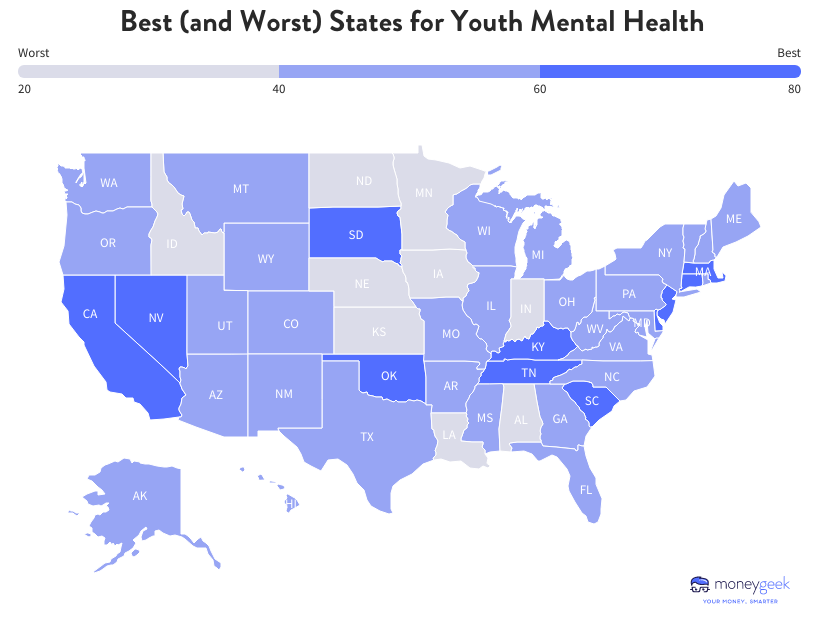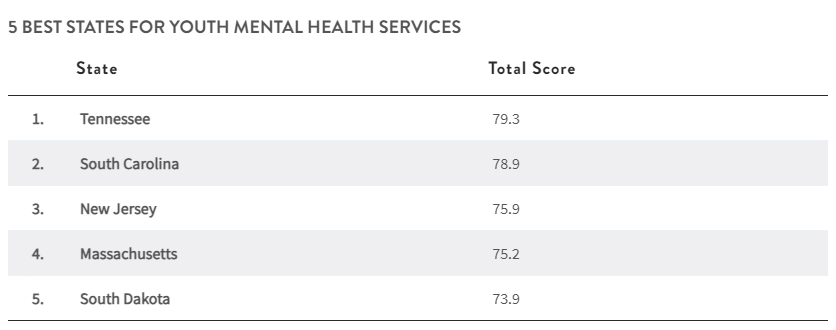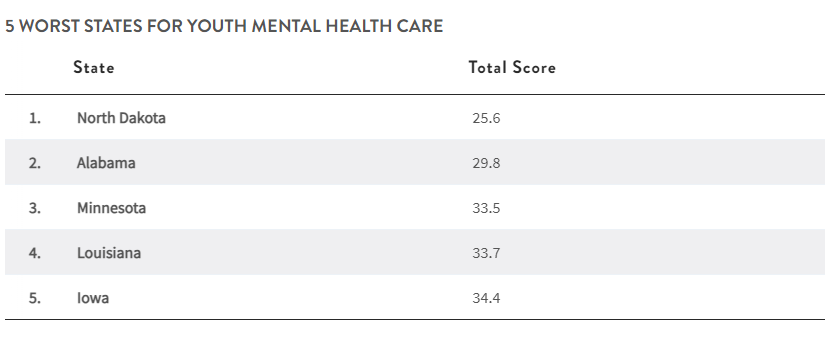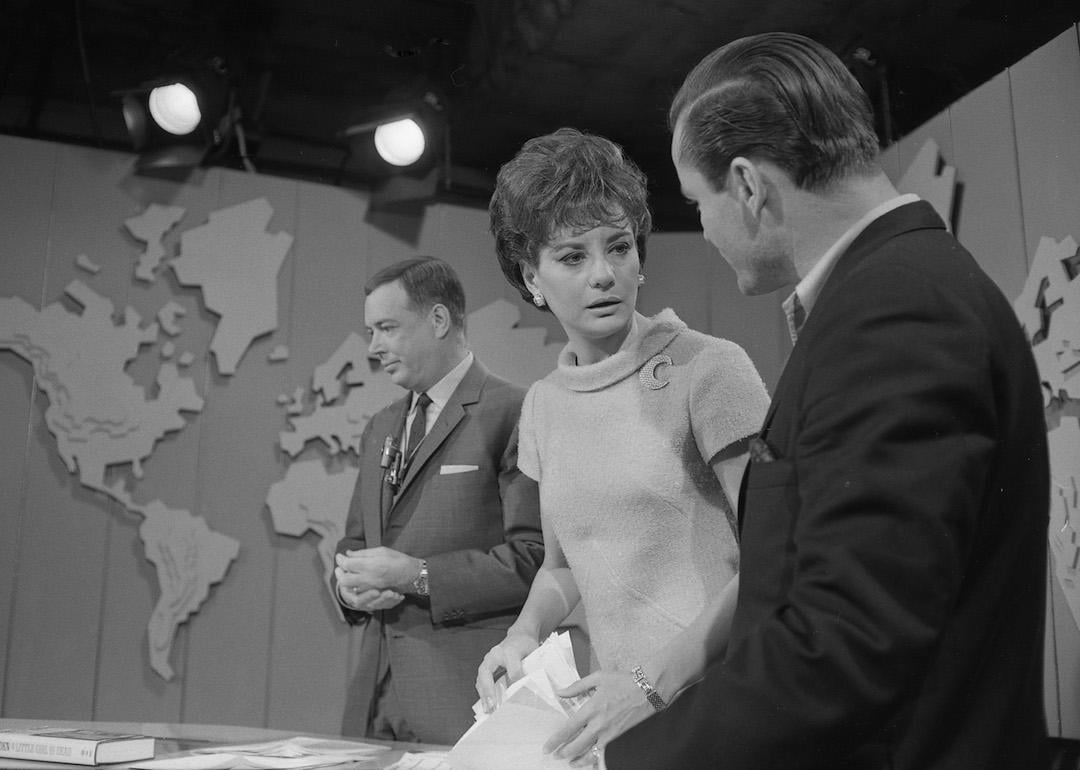
The South and Northeast are leading in youth mental health care, while the Midwest struggles
The South and Northeast are leading in youth mental health care, while the Midwest struggles
Young people in the United States are facing a mental health crisis. According to the Centers for Disease Control and Prevention (CDC), more than one-third of American teens report persistent feelings of sadness or hopelessness, and 15% have had an episode of major depression. Nearly 10% of children ages three to 17 have been diagnosed with anxiety or depression, and a 2023 study published in the Journal of Adolescent Health found that these rates are increasing over time. The U.S. Surgeon General issued an advisory in 2021 to call attention to youth mental health as an urgent public health issue, detailing contributing factors such as the pandemic and social media.
To explore the best and worst states for youth mental health care, MoneyGeek analyzed data from the U.S. Census Bureau, the Substance Abuse and Mental Health Services Administration (SAMHSA), and the CDC, as well as Google trends data on searches for relevant mental health terms. We ranked states by access to and cost of mental health care, as well as mental health needs in the young population.

Key findings
- The South has some of the best — and worst — states for youth mental health. Tennessee and South Carolina are the top states overall for access to and cost of mental health care, plus lower rates of mental health issues among youth. On the other hand, Alabama and Louisiana both appear in the bottom five states.
- Some of the worst states for youth mental health are in the Midwest. North Dakota ranked absolute last nationally due to the lowest scores on access and cost, along with relatively high rates of mental health burdens. Minnesota and Iowa also appear in the bottom five states. Overall, six out of the ten worst states are in the Midwest.
- For kids with mental health challenges, the Northeast is the best region for access to care. Massachusetts took the top spot for access to and cost of mental health care, while five of the six New England states ranked in the top ten for access and cost. However, some of these states have relatively high rates of mental health difficulties.
- California has some of the lowest rates of youth mental health conditions. Nevertheless, 13% of households report having at least one child who is struggling with mental health issues, and 15% of youth have had at least one major depressive episode.
- Vermont sees some of the highest rates of youth mental health issues, with one-quarter of households having at least one child who struggles with mental health issues and more than 20% of youth experiencing at least one major depressive episode. However, Vermont ranks among the best states for access to and cost of mental health care.

Top 5 states for youth mental health are clustered in the South and Northeast
The South took the top two spots for best states for youth mental health, followed by two states in the Northeast. Although overall scores in the top states were similar, how states achieved high rankings differed.
Tennessee scored well on access to and cost of care while also having relatively lower rates of mental health conditions. South Carolina follows with extremely low rates of mental health issues and strong performance on access and cost.
Similarly, New Jersey had above-average scores for access and cost but very low rates of mental health conditions. Massachusetts, on the other hand, earned the top score for access and cost and just about average rates of mental health difficulties. Rounding out the top five, South Dakota bucked the Midwest's performance trend with relatively strong scores across multiple dimensions.

The Midwest has some of the worst states for youth mental health care
Three of the five worst states for youth mental health care are located in the Midwest. Although North Dakota has about average rates of youth mental health issues, the state struggles with access and cost. The state has an especially low number of mental health providers (30 providers per 100,000 people) and a relatively high percentage of youth with private insurance that doesn't cover mental health or emotional problems (14%).
Minnesota and Iowa have more balanced results, with both landing in the bottom five due to low scores on access and cost and rates of mental health issues. Although states have many more mental health providers per capita than North Dakota and average or above average mental health facility capacity, both were at the bottom in terms of cost.
Key insights: Best (and worst) states for access, cost, and mental health
There are clear differences in the prevalence of mental health conditions by state. Similarly, access to and cost of mental health care vary widely based on the availability of mental health providers and facilities. MoneyGeek ranked the best and worst states for these two dimensions below.
Best and worst states for mental health access and cost
Though the Northeast generally has a high cost of living, five of the six New England states were in the top seven states for access and cost (with three of them tied for fifth place overall). All five of these Northeastern states have high or extremely high rates of mental health burdens, but the states are relatively well-equipped to handle widespread mental health needs. Massachusetts tops this list with the highest score for access and cost, largely due to high numbers of mental health providers per capita (194) and low rates of kids whose private insurance doesn't cover their mental health needs (6%).
The best states for youth mental health treatment access and cost, following Massachusetts, are Connecticut, Kentucky, Tennessee, and (in a three-way tie) Rhode Island, Maine, and Vermont.
The Southern states appearing in the bottom five nationally were well below the national average for number of youth mental health facilities and overall number of mental health providers while still having relatively high costs. Texas, in particular, had extremely low numbers of mental health facilities (seven per 100,000 minors) and a high rate of children whose private insurance did not cover the costs of mental health care (19%).
The worst states for youth mental health treatment access and cost are North Dakota, Alabama, Nebraska, Texas, and Louisiana.
States with the highest and lowest rates of mental health difficulties
The West and South dominated the list of states with the lowest rates of mental health difficulties. California took the top spot, with the highest possible score on this measure. California's youth are relatively less likely to have had a major depressive episode than the national average, and families are relatively less likely to live in a household with at least one child who has mental health needs. Following California, the states with the lowest rates of youth mental health needs are South Carolina, Arkansas, Nevada, and Georgia.
Meanwhile, some of the best states for access to mental health care were among those with the highest rates of mental health issues. For example, Vermont ranks fifth in terms of access to and cost of youth mental health care, but it has the highest rates of youth mental health problems in the country. The state has the third-highest percentage of youth who have experienced at least one major depressive episode (21%) and the fourth-highest percentage of households where at least one child struggles with mental health (25%). Following Vermont, the states with the most youth mental health needs are Utah, Maine, Idaho, and Oregon.
Tips for supporting your child's mental health
Children are facing mental health challenges at unprecedented rates. But no matter where you live, there are ways to close the gap between the care that's available and the care your child needs:
Remember that kids need specialized care
If you live in a state with good (or bad) mental health care for adults, that doesn't mean it will be the same for kids. Not all mental health providers have expertise in treating children and adolescents. Seek specialty care to address your child's unique mental health needs. If in-person providers aren't available in your area, telehealth can help fill that gap.
Choose health insurance carefully
When looking for the best health insurance for your family, don't just look at the cheapest plans. Make sure your plan covers mental health care and gives you access to mental health providers. Compare providers based on overall value, not just price.
Learn the signs of mental health struggles in children and adolescents
It can be challenging to tell the difference between typical teenage moodiness and a young person who is clinically struggling. If you're concerned or even just curious, read up on the most common mental health challenges in kids, as well as their symptoms and treatments.
Don't be afraid to ask for help. If your child is in crisis, contact the 988 Suicide and Crisis Helpline.
Methodology
To explore and rank the best states for youth mental health services by state, MoneyGeek considered eight metrics across two categories: access and cost, and prevalence. We ranked each state in every metric before calculating a final ranking score through a weighted average for each category. Each metric was given a full weight except for the following: the number of youth mental health treatment facilities per 100,000 people under 18 and the percentage of total mental health facilities that accept youths were both half-weighted. The state with the highest final score ranks as the best state for mental health services.
Access and Cost
- Number of mental health treatment facilities catering to individuals up to age 17, measured per 100,000 people under 17. Data comes from the Department of Health and Human Services 2021 National Substance Use and Mental Health Services Survey.
- Percentage of total mental health facilities that accept youth under 17. Data comes from the Department of Health and Human Services 2021 National Substance Use and Mental Health Services Survey.
- Mental health providers per 100,000 people. Data comes from the 2021 Census ACS PUMS Microdata and the Census Bureau's 2021 1-year American Community Survey.
- Percentage of youth with private insurance that did not cover mental or emotional problems. Data comes from Mental Health America's Youth Ranking for 2023.
- Average percentage of survey respondents that struggled with mental health costs. The survey included two questions: one asking if participants needed therapy but didn't receive it due to cost in the past 12 months, and the other inquiring about delays in therapy due to cost in the past 12 months. Data comes from the National Center for Health Statistics National Health Interview Survey for 2022.
Prevalence
- Percentage of youth with at least one major depressive episode. Data comes from Mental Health America's Youth Ranking for 2023.
- Average search volume for mental health services. This measures Google Trends search volume for the following keywords: "Child Anxiety" and "Child Depression." Data covers the 12-month period from November 29, 2022, to November 2023.
- Percentage of households where at least one child struggles with mental health. Data comes from the United States Census Bureau Household Pulse Survey from October 18 to October 30, 2023.
Full dataset
Our data illustrates the disparities in youth mental health services across various states, identifying the best and worst states across different criteria. The data that shaped this story can be found in full here.
This story was produced by MoneyGeek and reviewed and distributed by Stacker Media.



